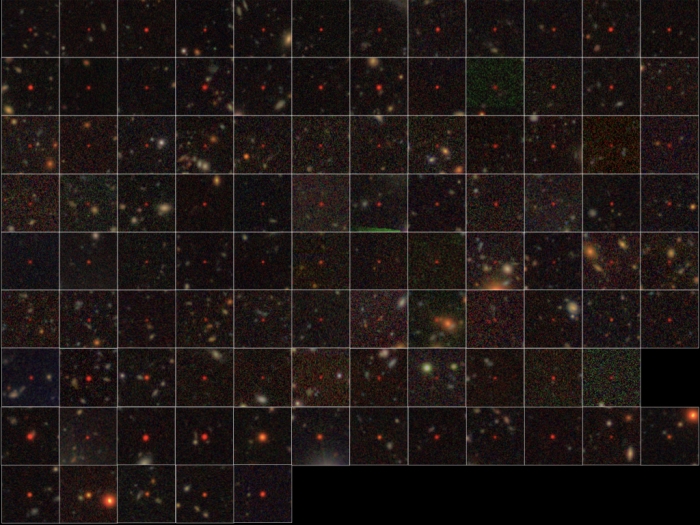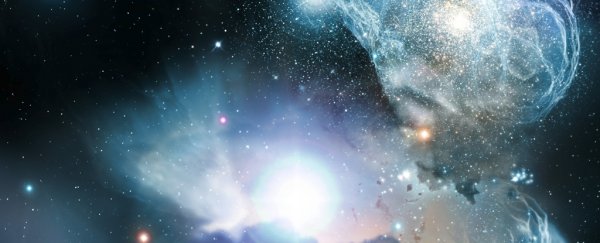Astronomers have just found 83 quasars, powered by supermassive black holes and dating back to the infancy of the Universe, when it was less than 10 percent of its current age.
This discovery reveals that such objects were more common at the dawn of time than we thought, and challenges our entire cosmological model.
Quasars are among the brightest objects in the Universe, extremely luminous galactic cores powered by actively feeding supermassive black holes. As material swirls around the black hole, its friction generates such intense radiation that it can be seen, even from billions of light-years away.
There's just one big problem. We think we know how black holes form - they are the collapsed cores of massive stars. And supermassive black holes can have up to billions of times the mass of the Sun.
This takes time, and requires copious amounts of matter. So how the heck did all these quasars pop up so early in the Universe's history?
"It is remarkable that such massive dense objects were able to form so soon after the Big Bang," said astrophysicist Michael Strauss of Princeton University.
"Understanding how black holes can form in the early Universe, and just how common they are, is a challenge for our cosmological models."
 A quasar 13.05 billion light-years away. (National Astronomical Observatory of Japan)
A quasar 13.05 billion light-years away. (National Astronomical Observatory of Japan)
We've known there were quasars hanging out back then. The oldest one we've seen dates back to around 690 million years after the Big Bang, when the Universe was around five percent of its current age - and a few others have been spotted too.
But these - although still a puzzle - were thought to be relatively rare. So astronomers from Japan, Taiwan and the US broadened the search, using data from the Hyper Suprime-Cam mounted on the Subaru Telescope in Hawaii.
With this instrument, they could look for much fainter quasars than ones discovered previously. The oldest quasar they found was a massive 13.05 billion light-years away, tying for the second-most distant quasar ever found.
The Universe is thought to be about 13.8 billion years old, and the first stars - we think - didn't appear until around 500 million years after the Big Bang, after the neutral hydrogen of the early-early Universe was reionised. That just leaves a couple of hundred million years for the quasars to form.
The team's survey suggests that these objects were actually fairly abundant back then. They identified candidate quasars in the HSC data, then conducted a dedicated survey using multiple telescopes to obtain light signatures, or spectra, from these objects.
 (National Astronomical Observatory of Japan)
(National Astronomical Observatory of Japan)
These spectra turned up the 83 new quasars, over the last few years. Together with 17 previously known quasars in the survey region, the team calculated that there's roughly one quasar for every cubic giga-light-year; that is, cube of space with a billion light-years per side.
While that's more than previously thought, it's not quite enough for another hypothesis.
Just after the Big Bang, the Universe was a sort of dark, hot "primordial soup" on a cosmic scale, rapidly expanding.
As it expanded, it cooled, causing protons and neutrons to start to combine into ionised hydrogen atoms; around 240,000-300,000 years after the Big Bang, these hydrogen atoms attracted electrons, coalescing into neutral hydrogen.
But it wasn't until gravity started to pull together the first stars and galaxies in this murky, hydrogen-filled void that starlight appeared… and not long after that, according to current theories, the neutral hydrogen was excited by the ultraviolet light of these newborn stars, galaxies, as-yet undetected quasars, or a combination of all three.
This is called the Epoch of Reionisation, and we just don't know how it happened. But now we know - based on this research - there weren't enough quasars to be solely responsible for this process.
The new quasar population data will help us learn more about the formation of supermassive black holes in the early Universe - and the team is going to continue the search to see if they can find quasars that are even older. This could help researchers to figure out when the first black holes were born.
"The quasars we discovered will be an interesting subject for further follow-up observations with current and future facilities," said astronomer Yoshiki Matsuoka of Ehime University in Japan.
"We will also learn about the formation and early evolution of supermassive black holes, by comparing the measured number density and luminosity distribution with predictions from theoretical models."
The discoveries have been detailed in five papers, which can be found here, here, here, here and here.
